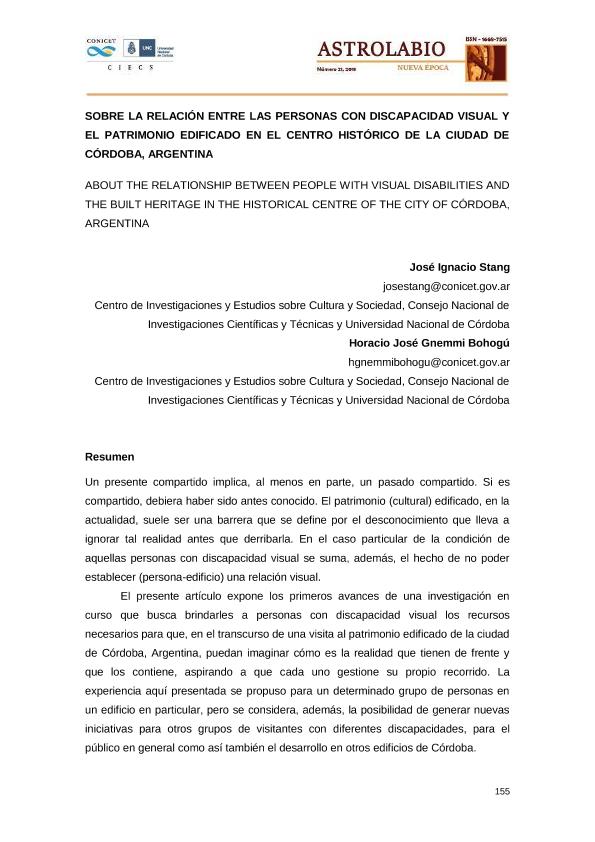Mostrar el registro sencillo del ítem
dc.contributor.author
Stang, José Ignacio

dc.contributor.author
Gnemmi Bohogú , Horacio Jose
dc.date.available
2019-11-19T17:48:19Z
dc.date.issued
2018-12
dc.identifier.citation
Stang, José Ignacio; Gnemmi Bohogú , Horacio Jose; Sobre la relación entre las personas con discapacidad visual y el patrimonio edificado en el centro histórico de la ciudad de Córdoba, Argentina; Centro de Investigaciones y Estudios sobre Cultura y Sociedad; Astrolabio; 21; 12-2018; 155-175
dc.identifier.issn
1668-7515
dc.identifier.uri
http://hdl.handle.net/11336/89210
dc.description.abstract
Un presente compartido implica, al menos en parte, un pasado compartido. Si es compartido, debiera haber sido antes conocido. El patrimonio (cultural) edificado, en la actualidad, suele ser una barrera que se define por el desconocimiento que lleva a ignorar tal realidad antes que derribarla. En el caso particular de la condición de aquellas personas con discapacidad visual se suma, además, el hecho de no poder establecer (persona-edificio) una relación visual. El presente artículo expone los primeros avances de una investigación en curso que busca brindarles a personas con discapacidad visual los recursos necesarios para que, en el transcurso de una visita al patrimonio edificado de la ciudad de Córdoba, Argentina, puedan imaginar cómo es la realidad que tienen de frente y que los contiene, aspirando a que cada uno gestione su propio recorrido. La experiencia aquí presentada se propuso para un determinado grupo de personas en un edificio en particular, pero se considera, además, la posibilidad de generar nuevas iniciativas para otros grupos de visitantes con diferentes discapacidades, para el público en general como así también el desarrollo en otros edificios de Córdoba. Es una investigación de carácter cualitativo que, como modalidad metodológica, propone el Estudio-Acción desde una lógica experiencial de conservación activa. El objetivo es profundizar en la comunidad el enriquecimiento de la memoria colectiva a partir de los bienes edificados, el reconocimiento de su autenticidad y sus valores cambiantes, y su apropiación por parte de quienes los habiten.
dc.description.abstract
A shared present implies, at least in part, a shared past. If it is shared, it should have been known before. The (cultural) heritage built up today is often a barrier defined by a lack of knowledge that leads to ignoring such a reality rather than tearing it down. In the particular case of the condition of visually impaired persons, the fact that they cannot establish (person-building) a visual relationship is also added. This article presents the first advances of an ongoing research that seeks to provide visually impaired people with the necessary resources so that, in the course of a visit to the built heritage of the city of Córdoba, Argentina, they can imagine how the reality that they have in front of them and that contains them is like, aspiring that each one can manage their own journey. The experience presented here was proposed for a certain group of people in a particular building, but it also considers the possibility of generating new initiatives for other groups of visitors with different disabilities, for the general public and also for development in other buildings in Córdoba. It is a research of a qualitative nature that proposes the Study-Action as a methodological modality, which implies a special epistemology and nosological perspective. The chosen approach also presupposes an experiential logic of active conservation. The objective is to deepen in the community the enrichment of the collective memory from the built up goods, the recognition of their authenticity and their changing values, and their appropriation by the community.
dc.format
application/pdf
dc.language.iso
spa
dc.publisher
Centro de Investigaciones y Estudios sobre Cultura y Sociedad
dc.rights
info:eu-repo/semantics/openAccess
dc.rights.uri
https://creativecommons.org/licenses/by-nc-sa/2.5/ar/
dc.subject
PATRIMONIO EDIFICADO
dc.subject
CONSERVACIÓN ACTIVA
dc.subject
ACCESIBILIDAD
dc.subject
PARTICIPACIÓN
dc.subject.classification
Ingeniería Arquitectónica

dc.subject.classification
Ingeniería Civil

dc.subject.classification
INGENIERÍAS Y TECNOLOGÍAS

dc.title
Sobre la relación entre las personas con discapacidad visual y el patrimonio edificado en el centro histórico de la ciudad de Córdoba, Argentina
dc.title
About the relationship between people with visual disabilities and the built heritage in the historical centre of the city of Córdoba, Argentina
dc.type
info:eu-repo/semantics/article
dc.type
info:ar-repo/semantics/artículo
dc.type
info:eu-repo/semantics/publishedVersion
dc.date.updated
2019-10-24T18:20:43Z
dc.journal.number
21
dc.journal.pagination
155-175
dc.journal.pais
Argentina

dc.journal.ciudad
Córdoba
dc.description.fil
Fil: Stang, José Ignacio. Consejo Nacional de Investigaciones Científicas y Técnicas. Centro Científico Tecnológico Conicet - Córdoba. Centro de Investigaciones y Estudios sobre Cultura y Sociedad. Universidad Nacional de Córdoba. Centro de Investigaciones y Estudios sobre Cultura y Sociedad; Argentina
dc.description.fil
Fil: Gnemmi Bohogú , Horacio Jose. Consejo Nacional de Investigaciones Científicas y Técnicas. Centro Científico Tecnológico Conicet - Córdoba. Centro de Investigaciones y Estudios sobre Cultura y Sociedad. Universidad Nacional de Córdoba. Centro de Investigaciones y Estudios sobre Cultura y Sociedad; Argentina
dc.journal.title
Astrolabio

dc.relation.alternativeid
info:eu-repo/semantics/altIdentifier/url/https://revistas.unc.edu.ar/index.php/astrolabio/article/view/17852
dc.relation.alternativeid
info:eu-repo/semantics/altIdentifier/url/https://dialnet.unirioja.es/servlet/articulo?codigo=6770388
Archivos asociados
